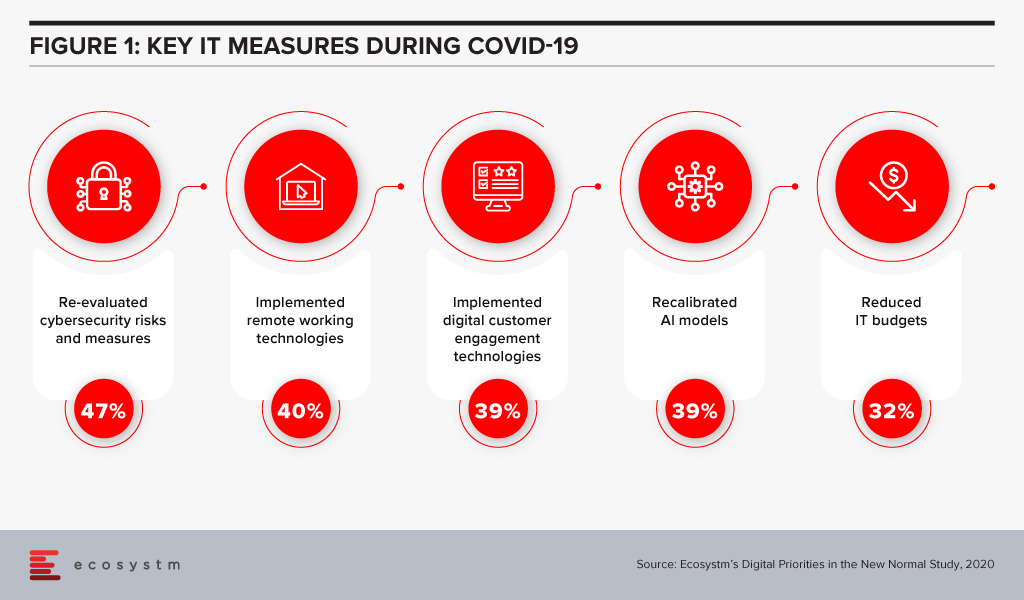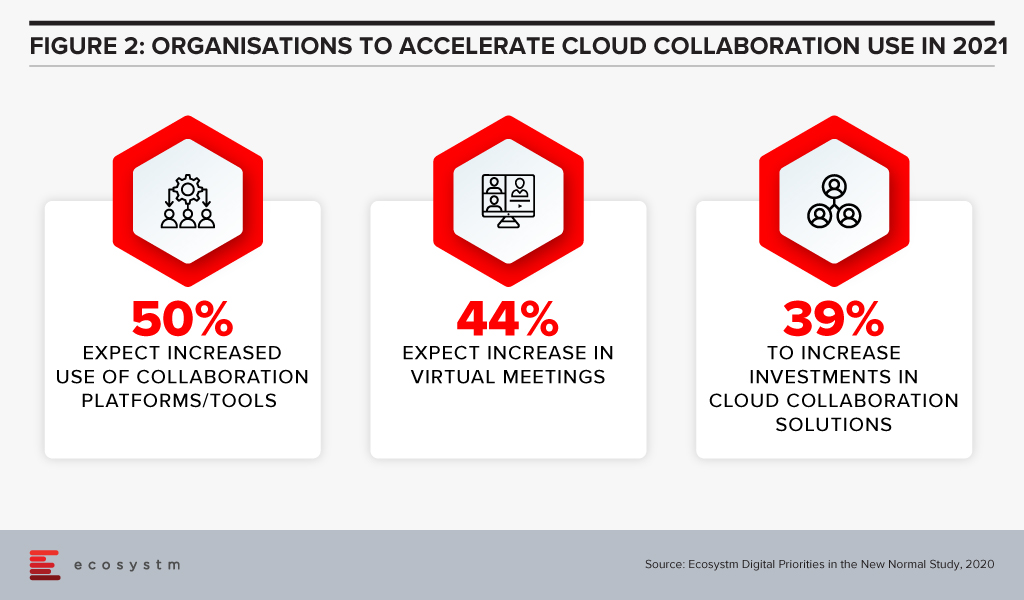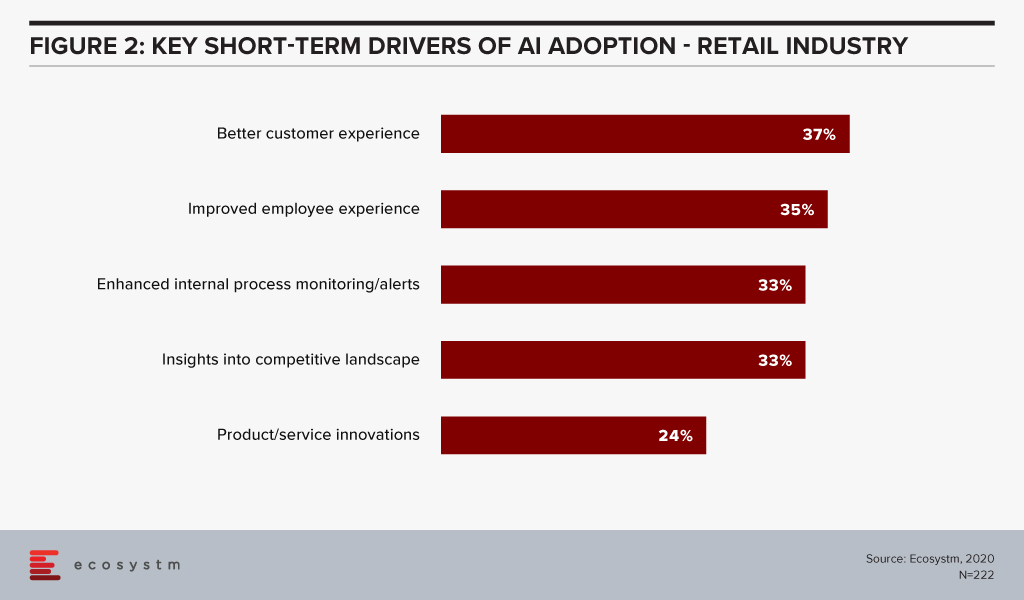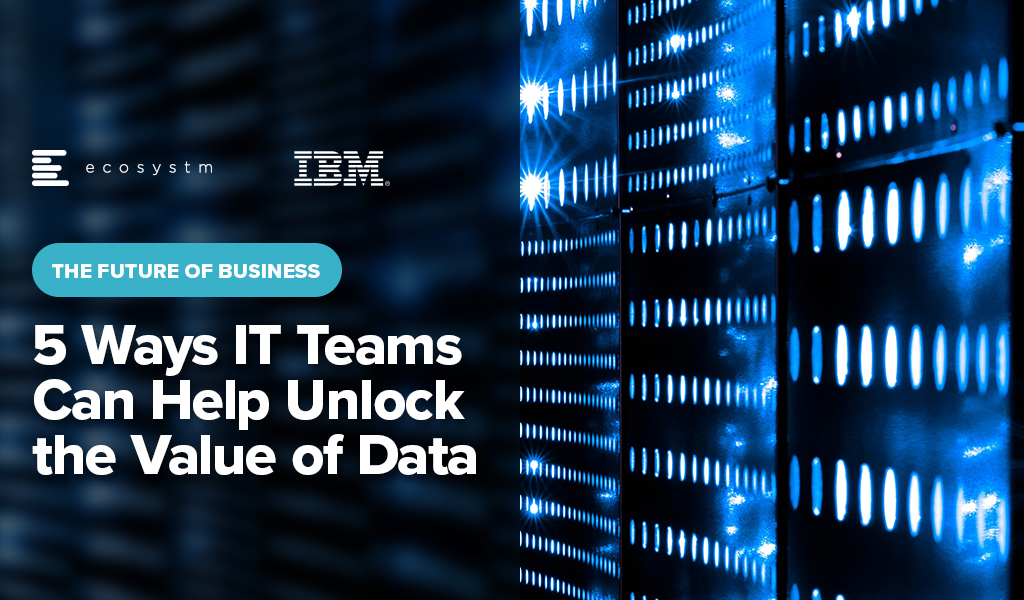Organisations will continue their quest to become digital and data-first in 2023. Business process automation will be a priority for the majority; but many will look at their data strategically to derive better business value.
As per Ecosystm’s Digital Digital Enterprise Study 2022, organisations will focus equally on Automation and Strategic AI in 2023.
Here are the top 5 trends for the Intelligent Enterprise in 2023 according to Ecosystm analysts, Alan Hesketh, Peter Carr, Sash Mukherjee and Tim Sheedy.
- Cloud Will Be Replaced by AI as the Right Transformation Goal
- Adoption of Data Platform Architecture Will See an Uptick
- Tech Teams Will Finally Focus on Internal Efficiency
- Data Retention/Deletion and Records Management Will Be Top Priority
- AI Will Replace Entire Human Jobs
Read on for more details.
Download Ecosystm Predicts: The Top 5 Trends for the Intelligent Enterprise in 2023 as a PDF

In the rush towards digital transformation, individual lines of business in organisations, have built up collections of unconnected systems, each generating a diversity of data. While these systems are suitable for rapidly launching services and are aimed at solving individual challenges, digital enterprises will need to take a platform approach to unlock the full value of the data they generate.
Data-driven enterprises can increase revenue and shift to higher margin offerings through personalisation tools, such as recommendation engines and dynamic pricing. Cost cutting can be achieved with predictive maintenance that relies on streaming sensor data integrated with external data sources. Increasingly, advanced organisations will monetise their integrated data by providing insights as a service.
Digital enterprises face new challenges – growing complexity, data explosion, and skills gap.
Here are 5 ways in which IT teams can mitigate these challenges.
- Data & AI projects must focus on data access. When the organisation can unify data and transmit it securely wherever it needs to, it will be ready to begin developing applications that utilise machine learning, deep learning, and AI.
- Transformation requires a hybrid cloud platform. Hybrid cloud provides the ability to place each workload in an environment that makes the most sense for the business, while still reaping the benefits of a unified platform.
- Application modernisation unlocks future value. The importance of delivering better experiences to internal and external stakeholders has not gone down; new experiences need modern applications.
- Data management needs to be unified and automated. Digital transformation initiatives result in ever-expanding technology estates and growing volumes of data that cannot be managed with manual processes.
- Cyber strategy should be Zero Trust – backed by the right technologies. Organisations have to build Digital Trust with privacy, protection, and compliance at the core. The Zero Trust strategy should be backed by automated identity governance, robust access and management policies, and least privilege.
Read below to find out more.
Download The Future of Business: 5 Ways IT Teams Can Help Unlock the Value of Data as a PDF

In recent years, businesses have faced significant disruptions. Organisations are challenged on multiple fronts – such as the continuing supply chain disruptions; an ongoing energy crisis that has led to a strong focus on sustainability; economic uncertainty; skills shortage; and increased competition from digitally native businesses. The challenge today is to build intelligent, data-driven, and agile businesses that can respond to the many changes that lie ahead.
Leading organisations are evaluating ways to empower the entire business with data, machine learning, automation, and AI to build agile, innovative, and customer-focused businesses.
Here are 7 steps that will help you deliver business value with data and AI:
- Understand the problems that need solutions. Before an organisation sets out on its data, automation, and AI journey, it is important to evaluate what it wants to achieve. This requires an engagement with the Tech/Data Teams to discuss the challenges it is trying to resolve.
- Map out a data strategy framework. Perhaps the most important part of this strategy are the data governance principles – or a new automated governance to enforce policies and rules automatically and consistently across data on any cloud.
- Industrialise data management & AI technologies. The cumulation of many smart, data-driven initiatives will ultimately see the need for a unified enterprise approach to data management, AI, and automation.
- Recognise the skills gap – and start closing it today. There is a real skills gap when it comes to the ability to identify and solve data-centric issues. Many businesses today turn to technology and business consultants and system integrators to help them solve the skills challenge.
- Re-start the data journey with a pilot. Real-world pilots help generate data and insights to build a business case to scale capabilities.
- Automate the outcomes. Modern applications have made it easier to automate actions based on insights. APIs let systems integrate with each other, share data, and trigger processes; and RPA helps businesses automate across applications and platforms.
- Learn and improve. Intelligent automation tools and adaptive AI/machine learning solutions exist today. What organisations need to do is to apply the learnings for continuous improvements.
Find more insights below.
Download The Future of Business: 7 Steps to Delivering Business Value with Data & AI as a PDF

Authored by Alea Fairchild and Audrey William
Video conferencing company Zoom hosted its virtual Zoomtopia user conference lasts week. Given the attention the company has received as the de-facto standard video communication service for the many stranded work-from-home folks, Zoom has been using the event to launch a number of new products. This includes bringing into general availability its OnZoom events platform and marketplace, and introducing Zapps which brings apps from other providers into the Zoom experience.
ZaaP!
In this age of work-from-home connectivity, we are all asked to multi-platform depending on customer preference, company standards and choice of scale-out from a licensing perspective. But will video-led unified communications help position Zoom to be the infrastructure platform of choice of the workforce? Will Zoom as a Platform (ZaaP!) become a well-used phrase to discuss unified collaboration infrastructures?
The agenda of Zoomtopia, covering healthcare, government, financial services, sales engagement, blending learning in education, mindfulness, CSR, and a whole gambit of other vertical topics, demonstrates a virtual play to highlight use cases where other platforms have focused on the horizontal aspect of productivity.
If you compare Microsoft’s horizontal approach with Cisco’s networking approach, both come from places of productivity. Zoom, being video-led and UC oriented, comes from a place of communication and collaboration. Is collaboration now the real driver for the future of work?
Zoom connects the dots with these two product introductions. Zapps is designed to link productivity tools directly into the Zoom experience for user access to multiple applications from the platform. OnZoom allows hosts to run one-time events or event series with up to 100 or 1,000 attendees (depending on their license) and sell tickets for them. Zoom is also integrating the ability to receive donations through events via Pledgeling. Think a combination of EventBrite meeting GoFundMe meeting Facebook Events.
Zooming Ahead
With the wide variety of activities during this social distancing period around the world that have been Zoom-powered, familiarity leads to experimentation and early adoption.
Without using the word ‘portal’ – Zoom as a Platform (ZaaP!) enforces the drive for a main infrastructure for live interaction via video as the main means of communication over written material or pre-recorded media materials. And many of us are video-led, more than ever.
Zoom is scaling rapidly. When it started out many years ago, they were known as a company that offered video sessions for free and everyone was wondering who this new kid on the block was. In a span of a few years, they have become a powerhouse.
The announcement of OnZoom is something that marketeers will take note of. Many marketeers are Zoom users but could be using other platforms for hosting events. The solution will have in-built tools for selling tickets, scheduling, gifting tickets, promotional activities, etc. Zoom is thinking about video and layering that with added functionality to run a large-scale event. You can see them going into using AI to churn out rich analytics on attendees, attendance rates, effectiveness of campaigns and so on. All of a sudden it is about hosting an event with in-built rich features plus analytics so events can be run better. They are reaching a new audience and making it a fully built all-purpose solution for event organisers and marketeers.
Security Front and Centre
Ecosystm research shows that security has been a key component in organisation’s COVID-19 responses – and rightly so (Figure 1).

While Zoom received some negative publicity this year around security, they were quick to admit the issues and made incremental changes in the subsequent months including an acquisition. With E2EE, no third party including Zoom is provided with access to the meeting’s private keys. Zoom’s E2EE ensures that communication between meeting participants using Zoom applications is encrypted using cryptographic keys known only to the devices of those participants. Zoom is starting to penetrate larger accounts and the security aspect is important as it is the top of the mind discussion for every business leader.
Ecosystm Comments
With the hybrid work model evolving between home and work, and work patterns changing, one thing that is going to stay is the use of video and collaboration tools and it is only going to accelerate (Figure 2).

What Zoom is doing well is how they take workflows and APIs seriously, making productivity flow into UC and UX, and not the other way around.
With longer work hours becoming a norm, growing instances of emotional stress and mental fatigue, UX becomes paramount. Knowledge workers want to seamlessly move between workflows and still find the experience simple and not tiring. Zoom is building on that vision as a platform enabler and infrastructure provider.

During this pandemic, shoppers who have experienced new forms of delivery direct from manufacturers, curbside pickup and eCommerce via wholesalers will likely adopt at least some of those habits in their everyday lives in future. Why? Ease of use, convenience, hygiene and guaranteed product availability, all factor into this shift.
Most retailers were not ready for a rush of online shoppers or structured for a Buy Online Pickup In-Store (BOPIS) model. They struggled to pivot with their own delivery set-up, both in terms of staffing and infrastructure. Delivery slots were rare and required midnight countdowns to the next day’s set of slots with online confusion. Many grocery retailers initially stopped curbside deliveries due to lack of resources for fulfilment in store.
And for SME retail outlets, square meterage limits the number of customers inside at a time and social distancing measures limit handling curbside pickups. Supply chain issues and inventory management also played a role, with local inventory visibility a real factor in determining order placement.
As shown in Figure 1, Ecosystm research shows that supply chain optimisation and demand forecasting are both listed in the top five business solutions that firms in retail consider using AI for.
Hybrid Operations
How can retail firms, with both perishable and non-perishable goods, use AI, automation and other infrastructural investments to develop the near-term future of curbside retail? We suggest the use of hybrid operations.
Retailers are starting to look at developing hybrid operations: part retail space and part fulfilment centre. Allowing customers to enter only part of the store or pulling inventory off the shelf to a different part of the store for deliveries expands reach and allows fulfilment without decreasing the experience for customers who prefer to shop in-store. But it requires an IT infrastructural upgrade to make it happen.
In the medium term, leveraging automation will be one of the ways supermarkets and other retailers evolve their models to remain viable and profitable.
What can be automated?
Let’s define these automated delivery infrastructural options:
- Curbside pickup is the endpoint of manual sorting and selecting operation, and then the goods are ready for pickup with a vehicle outside the store.
- Micro-fulfilment centres are locations with a logistics company to maximise space in traditional stores and expand online options. Micro-fulfillment helps retailers solve the labour and last-mile costs conundrum as it brings the goods closer to the end customer.
- Dark stores are traditional retail stores that have been converted to local fulfilment centres.
None of these concepts are new, but as alternatives to traditional retail in the current environment, they are viable options. Having curbside pickup, micro-fulfilment centres or dark stores help ease transitions towards traditional operations while still protecting customers and employees. Figure 2 from our AI research at Ecosystm shows that better customer experience is a top short-term driver in retail AI deployment.
Restructuring the three factors of production
By using AI and inventory automation, retailers can focus on rightsizing the three factors of production:
- Labour. Reducing the staffing cost to produce the same volume of sales.
- Inventory. Giving the retailer the tools to replenish stores with more specific information on consumption and wastage.
- Physical Space. Enabling dynamic adjustments of product display allows alignment more closely with sales patterns within the physical store. This can be adjusted for within the week and even by day.
Retailers are looking to speed delivery by dispersing inventory closer to customers. They use automation to build more compact distribution operations by using hybrid operations.
Designing hybrid operations with technology
To develop a hybrid operation, what IT infrastructural elements need to be addressed?
Store layout. Hybrid operations should drive efficiency in delivery, based on time and motion, but without impacting in-store shoppers. Order pulling should structurally happen towards the back of the store, both for efficiency and ease of access to move goods. To maintain product quality, networks and sensors need to be installed.
Process training. Hybrid operations are system dependent. Skilled staff who pick items for delivery require systems that implement standard procedures for selection and bundling. Processes require system automation for checks to mitigate high levels of wastage. Operational implementations need to include systems that manage cut-off times and back-room management.
Order management and inventory management systems. Analytics help retailers to stock popular items. They can then ensure these are easily accessible both front and back of the store. Retailers need to prioritise inventory management to make the most of inventory visibility across hybrid operations. SKUs and barcodes should be simple, consistent and unique.
Learning from innovative IT models in Grocery
In California, Sysco expanded its direct-to-the-consumer pop-up format to help give shoppers in the area access to fresh grocery items. Whole Foods expanded its dark store concept in Texas in combination with Amazon. Aldi in the UK rolled out an online program to distribute grocery parcels to consumers who were self-isolating, with 22 different goods in the bundle including toilet paper and anti-bacterial gel.
Market ownership will come from a better shopping experience. Streamlining processes and automating order fulfilment using IT in a hybrid retail operation could help lessen the financial and logistical strain of maintaining social distancing and proper hygiene measures.



































